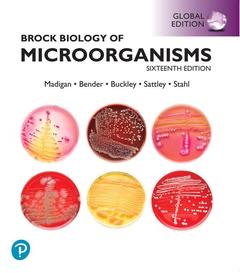Description
Brock Biology of Microorganisms, Global Edition (16th Ed.)
Authors: Madigan Michael, Aiyer Jennifer, Buckley Daniel, Sattley W., Stahl David
Language: English
Subject for Brock Biology of Microorganisms, Global Edition:
81.73 €
In Print (Delivery period: 14 days).
Add to cart1128 p. · 24.5x27.5 cm · Paperback
Description
/li>Contents
/li>Biography
/li>Comment
/li>
Get a solid understanding of the major concepts in microbiology with a textbook t hat offers cutting-edge research findings, powerful tools, and visuals.
Brock Biology of Microorganisms, Global Edition, 16th Edition is the latest version of the most authoritative textbook in the field, offering powerful, accurate, yet accessible content surrounding the basic concepts of microbiology.
The text guides you through the six major themes of microbiology ? Evolution, Cell Structure and Function, Metabolic Pathways, Information Flow and Genetics, Microbial Systems, and the Impact of Microorganisms ? as outlined by the American Society for Microbiology Conference on Undergraduate Education (ASMCUE).
Following a modern robust approach, the book supports your knowledge of the genomics and other omics" maze - concepts that are fundamental to the field and have transformed and revolutionised microbiology. Furthermore, it provides concrete examples of how powerful tools have allowed microbiologists to probe deeper and further into the microbial world than ever before.
UNIT 1: THE FOUNDATIONS OF MICROBIOLOGY
- The Microbial World
- Microbial Cell Structure and Function
- Microbial Metabolism
- Microbial Growth and Its Control
- Viruses and Their Multiplication
UNIT 2: MOLECULAR BIOLOGY AND GENETICS
- Microbial Information Flow and Protein Processing
- Microbial Regulatory Systems
- Molecular Aspects of Microbial Growth
- Genetics of Bacteria and Archaea
UNIT 3: GENOMICS, SYNTHETIC BIOLOGY, AND EVOLUTION
- Microbial Genomics and Other Omics
- Viral Genomics and Diversity
- Biotechnology and Synthetic Biology
- Microbial Evolution and Genome Dynamics
UNIT 4: MICROBIAL DIVERSITY
- Metabolic Diversity of Microorganisms
- Ecological Diversity of Bacteria
- Phylogenetic Diversity of Bacteria
- Phylogenetic Diversity of Archaea
- Diversity of Microbial Eukarya
UNIT 5: MICROBIAL ECOLOGY AND ENVIRONMENTAL MICROBIOLOGY
- Taking the Measure of Microbial Systems
- Microbial Ecosystems
- Nutrient Cycles
- Microbiology of the Built Environment
- Microbial Symbioses with Microbes, Plants, and Animals
UNIT 6: MICROBE – HUMAN INTERACTIONS AND THE IMMUNE SYSTEM
- Microbial Symbioses with Humans
- Microbial Infection and Pathogenesis
- Innate Immunity: Broadly Specific Host Defenses
- Adaptive Immunity: Highly Specific Host Defenses
- Immune Disorders and Antimicrobial Therapy
UNIT 7: INFECTIOUS DISEASES
- Diagnosing Infectious Diseases
- Epidemiology and Public Health
- Person-to-Person Bacterial and Viral Diseases
- Vectorborne and Soilborne Bacterial and Viral Diseases
- Waterborne and Foodborne Bacterial and Viral Diseases
- Eukaryotic Pathogens: Fungi, Protozoa, and Helminths
Michael T. Madigan has taught courses in introductory Microbiology and Bacterial Diversity for 33 years as a Professor of Microbiology at the Southern Illinois University Carbondale. Mike's research focuses on phototrophic bacteria that inhabit extreme environments, and for the past 20 years, his emphasis has been Antarcticmicrobiology.
Kelly S. Bender is' an Associate Professor at Southern Illinois University Carbondale and has served as Chair of the SIUC Department of Microbiology since 2018. Kelly teaches courses in introductory Microbiology and Microbial Diversity, and her lab studies a range of topics, including regulation of sulphate-reducing bacteria and the microbial community dynamics of sites impacted by acid mine drainage.
Daniel H. Buckley is a Professor at Cornell University in the School of Integrative Plant Science and the Department of Microbiology. He has taught both introductory and advanced courses in Microbiology, Microbial Diversity, and Microbial Genomics. He currently serves on the editorial boards of Applied and Environmental Microbiology and Environmental Microbiology.
Matthew Sattleyis a Professor of Biology at the Division of Natural Sciences, Indiana Wesleyan University (IWU), and has served as the Director of the Hodson Summer Research Institute, a faculty-led summer research program for undergraduate students in the Natural Sciences. Matt’s research group investigates the ecology, diversity, and genomics of bacteria that inhabit extreme environments.
David A. Stahl is a Professor in the Departments of Civil and Environmental Engineering and M
Hallmark features of this title
Helping students connect essential concepts across the text- Evolution as a Framework connects microbiological concepts from an evolutionary aspect further supporting your students' understanding.
- Concrete examples demonstrate how valuable resources and powerful tools have allowed microbiologists to probe deeper and further into the microbial world.
- Cutting-edge research findings illustrate basic concepts all students need to master.
- Impressive art program features complement the accessible content, providing a visual result to support your students' better understanding of the concepts.
- End-of-chapter content better assists student review and assessment.




